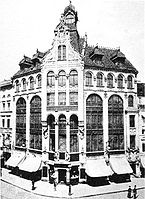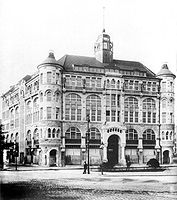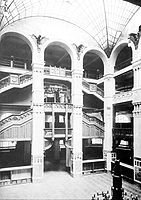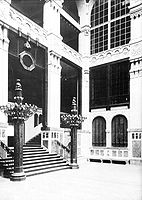Adolf Jandorf
Adolf Jandorf (born February 7, 1870 in Hengstfeld ; † January 12, 1932 in Berlin ; full name Abraham Adolf Jandorf ) was a German businessman and managing owner of the A. Jandorf & Co. department store chain . Due to his constant use of the most modern sales techniques , he got out simple relationships with one of the wealthiest large merchants in Germany. With the Kaufhaus des Westens (KaDeWe) in Berlin, he founded what is now Germany's most famous department store in 1907.
Life
Apprenticeship and wandering years
Adolf Jandorf came from a poor Jewish family in a small village on the Hohenlohe plain . He was the second of seven children of the farmer, butcher and cattle dealer Josef Bernhard Jandorf (1840–1913) and his wife Rika, b. Ansbacher (1843-1899). After graduating from the bar mitzvah and graduating from elementary school, he did a commercial apprenticeship in a small manufacturing shop in Bad Mergentheim from 1884 to 1887 , which was a hard and hard training with a seven-day working week. In 1890 he followed the eldest brother Louis, who had meanwhile emigrated, to the USA and tried to find the prodigal son there on behalf of the family. Despite a lack of language skills, he was able to track him down after eight days as a tram conductor in New York City ; but Louis could no longer be induced to return to the German Empire. During his self-financed stay, Adolf Jandorf got to know New York's department stores: Steward, Macy’s and Bloomingdale’s were the most modern department stores of their time.
Department stores founded in Berlin
At the Spittelmarkt
At the beginning of the 1890s, Jandorf worked in Bremerhaven for the Hamburg textile trading company M. J. Emden Söhne , a trading group that took on joint purchases both for its own account and for numerous independent merchants. His "quick [...] comprehension and easy [...] adaptability in his business decisions" caught the attention of the management, so that in 1892 he was commissioned by company boss Jakob Emden to set up a small business in the capital Berlin with an advance of 500 marks . After six weeks, Jandorf had opened his first shop on the Spittelmarkt at the corner of Leipziger Strasse , a shop with inexpensive trimmings , haberdashery and woolen goods. Contrary to the agreement, he reported the business on the company sign and stationery as supposed property, namely as A. Jandorf & Co., Hamburger Engros Lager . Jandorf was able to turn the inevitable conflict with Jakob Emden in his favor with a threat of resignation. However, as a cholera epidemic struck Hamburg in the same year , the addition of Hamburg to the name had a devastating effect on sales. Faced with such initial difficulties, Jandorf shortened the company name. The saving sales success brought a pillow with the wish embroidered only a quarter of an hour , which was sold more than a million times.
In 1894 he married Margarete Hirschfeld and shortly afterwards the birth of their only child Harry (1896–1981) followed. Jandorf worked all day in his department store from purchasing to accounting to decoration, so that his wife had to bring him the food. Business development was very successful. After a short time he was able to buy up the whole house and convert it into a small department store with 300 m² sales area. As a “people's store”, he wanted to reach his target group of the Berlin proletariat and other low-wage earners with simple and cheap goods .
Kreuzberg (1897)
The increasing demand soon made larger storage and sales rooms necessary, so that Jandorf, against Jakob Emden's reservations, built a second, larger department store on the corner of Belle-Alliance-Straße (today Blücherplatz 3) and Tempelhofer Ufer by architect Fritz Flatow from 1897 to 1898 let. It had two floors, a representative neo-baroque facade and initially had 1,500 m²; In 1899 an extension was built on the neighboring property. Jandorf should also always place its other department stores on a strategically well-located street corner. In 1922 he added a third floor to the building, the five neo-baroque roof attachments and the roof balustrade fell victim to the renovation.
Friedrichshain and Mitte
Further branches followed in 1901 in Große Frankfurter Straße 113 (today Karl-Marx-Allee 68), corner of Andreasstraße and in 1904 on the corner of Brunnen- and Veteranenstraße. The building on Karl-Marx-Allee was destroyed in the Second World War; its remains disappeared when the new Stalinallee was rebuilt .
The department store at Weinberg was a five-storey steel frame building, faced with a clearly structured natural stone facade, and the interior could be designed flexibly. The facade is adorned with bees as symbols of industry and with tracery in Art Nouveau style . The house survived the Second World War undamaged and served as an institute for fashion design in the GDR from 1953 , later the House of Fashion .
Charlottenburg
Jandorf had his sixth house built by the architect Alfred Lesser from 1905 to 1906 in Charlottenburg at 115 Wilmersdorfer Strasse at the corner of Pestalozzistrasse . At the end of the Second World War it was partially destroyed; Georg Karg from the Hertie department store chain had the department store restored from 1951 to 1955. Further conversions and additions followed; today there is a Karstadt branch here .
Kreuzberg (1906)
In 1906 he bought a finished building at Kottbusser Damm 1 in the workers' district of Kreuzberg , which was planned by Franz Ahrens and is also considered the first private reinforced concrete building in Berlin. This made him one of the ten largest department store entrepreneurs in Germany.
Jandorf department store, Kottbusser Damm, 1906, architect: Franz Ahrens
Jandorf department store, Wilmersdorfer Str. , Corner of Pestalozzistraße, around 1920
Department Store of the West
His seventh and last department store made history: Until then, Jandorf served the tangible needs of the ordinary people of Berlin, now it should be the upper and highest consumer demands of the Wilhelmine elite. For the Kaufhaus des Westens (KaDeWe) a separate company with limited liability was founded in 1905 by M. J. Emden Söhne with 79,000 marks and businessman Hermann Knauer with 1,000 marks. Jandorf initially stayed in the background, it was not until September 1906 that he contributed the main share with 1,921,000 marks, and Deutsche Bank took over the loan financing . In order to underline the leap in quality from a people's department store to a luxury department store, he also renounced his name in the department store's title.
Jandorf chose the border between the then still independent cities of Charlottenburg and Schöneberg at the end of Tauentzienstrasse as the location . With a subway connection at the Wittenbergplatz subway station and trams, the location was conveniently located and positioned with foresight, as a future traffic center would be located here as the cities merged into Greater Berlin . The saying “Wat een good location is, determine ick”, which is always ascribed to him in this context, cannot be substantiated with any source. Since no quotation from him has been passed down in the Berlin dialect , he probably spoke High German and the Main Franconian dialect . Between Ansbacher and Passauer Strasse, some 15-year-old residential buildings of the best quality had to be demolished before the department store was pulled up and completed within a year. The architect Johann Emil Schaudt planned the design with five floors and a sober, sober facade made of Franconian shell limestone . Merchant Hermann Knauer built the building with his company Boswau & Knauer . Interior designer Franz Habich , who had previously furnished the Oberpollinger department store in Munich , took on the interior design with wood paneling and natural stone, which was all described as “noble”, “modern” and “dignified”. The small-window structure of the facade adapted to the structure of the neighboring residential buildings and was also a consequence of a new building authority regulation that prohibited the presentation of goods behind large windows on the entire facade (such as the Tietz department store on Leipziger Strasse).
Capable executives were specifically recruited by other Berlin department stores, so the company A. Wertheim , in some cases before the merchant court processed. His brother Moritz Jandorf traveled to London for the technical infrastructure to study the pneumatic tube system and new sales techniques. A pneumatic tube system was then installed for the cash registers with a total length of 18 km and a central cash register, but the sales talent of manufacturer Lempson proved to be greater than the functionality of the system. The high susceptibility to repairs of the cables, which made it necessary for British technicians to travel frequently, resulted in their replacement by cash registers after just a few years. The additional services that KaDeWe offered in addition to the sale of goods in 120 departments were valued by customers and complained about by customers: “Hairdressing salons for men and women, the travel agency, the exchange office, refreshment and tea rooms, as well as a photographic studio and lending library ".
The opening took place on March 27, 1907 after an advertising campaign in the daily newspapers with large-format graphics in Art Nouveau by August Hajduk for the first time . In August 1907, King Chulalongkorn , Rama V of Siam , and his entourage went to the Kaufhaus des Westens for a two-day shopping trip, dined extensively in the prince's room and spent a total of 250,000 marks. This was the tacitly hoped for upgrading the KaDeWe by the high nobility, which made an impression on the court, the bourgeoisie and the civil servants. Rama V. awarded Jandorf the White Elephant Order in gratitude .
Attacks by retailers and anti-Semites
The Jandorf department store group, the Wertheim group , the Hermann Tietz group and Rudolph Karstadt's department stores were very successful in business. The high sales were at the expense of the established retail trade. He tried in vain with many measures to counter the growing customer interest. "Envy, resentment and increasingly open, organized attacks accompanied the triumphant advance of department stores in Germany from day one." Dealers with small shops concentrated their defense against this new type of business in interest groups such as the central board of commercial associations and associations in Germany . These forces succeeded in legally establishing so-called department store taxes in the state parliaments of Saxony in Hesse in 1897 and 1911 . In Prussia, too, in accordance with the Prussian Department Store Act of June 18, 1900, all trading companies that offered more than two out of four arbitrarily determined groups of goods and sold over 400,000 marks had to pay an additional tax based on sales. Often attempts were made to drastically restrict the construction of further department stores via building regulations. In 1906, for example, a bill was submitted to the Prussian state parliament , according to which, due to the risk of fire, sales were no longer allowed to take place above the first floor.
In addition, there were anti-Semitic abuse in the press, as the new type of department store was mostly founded and run by Jewish family businesses within a few decades. In 1932, a year before the Nazi dictatorship , 25% of German retailers were of Jewish origin, while the share among department store owners was 79%. In order to be able to parry such hostility better, Oscar Tietz initiated the establishment of the Association of German Department Stores in February 1903 and Jandorf took over a seat on the Presidium.
To check the legitimacy of Jandorf's wishes for the order, a file was created in the Berlin police headquarters . According to Jandorf's biographer Busch-Petersen in 2008, it reflects the efforts of German Jewry as a whole to gain social recognition. The delegation of the merit of the order to the responsibility of the police corresponded to the usual resentment towards Jewish merchants. The entries in Jandorf's files document a great receptivity to all negative rumors and tend to devalue gifts and donations for social institutions (such as the German Association for Children's Asylums or for the court theaters in Gotha and Detmold ). In April 1916, during the First World War , Police President Traugott von Jagow demanded in a memo that Jandorf be called up for military service in order to “take on at least a small part of the serious guilt that he has borne, if not legally, but morally to wash off his blood. ”The request was preceded by shuffles with inferior military boots to the Austrian army, which had been committed by two outside merchants of a delivery consortium without Jandorf's knowledge. After Jagow left for Breslau in 1916, there was no longer a call-up. Jandorf never received any official recognition of his services from the Prussian state; a Cross of Merit for War Aid was withdrawn at Jagow's instigation. The title of Kommerzienrat was given to Jandorf in 1910 by the Bavarian king, not by the Prussian. Numerous honors from the German federal states and abroad, such as the Japanese Order of the Holy Treasure , demonstrated Jandorf's good reputation.
Sale of department stores
When Jandorf's business partner MJ Emden Söhne sold their 19 department stores to Rudolph Karstadt AG in 1926, he soon decided to sell his department stores as well. At that time, the Jandorf Group employed over 3,000 people and was valued in the high double-digit million range. On December 2, 1926, the companies A. Jandorf & Co. and Hermann Tietz oHG announced in a joint communiqué that at the turn of the year 1927 all department stores and properties of the company Jandorf would become the property of Tietz. This made the Hermann Tietz OHG group of companies the largest department store group in Europe with annual sales of 300 million Reichsmark in 1928.
family
Jandorf brought in Karl (1872–1930), Robert (1875–1958), who actually wanted to become a rabbi , Moritz (* 1879) and, as corporate legal advisor , the doctorate lawyer Julius Jandorf (1883–1962), four of his brothers Management of his branches in Berlin. After the death of his wife Rika in October 1899, her father had sold his house and farm and moved into his son Adolf's house at Augsburger Strasse 23 in the Bavarian Quarter . His sons Robert, Moritz and Julius also lived there.
In 1920 Jandorf's wife Margarete died. In the fall of 1928 he married Helen Lehmann (1902–1965), who was baptized as a Protestant and converted to Judaism before the wedding. Jandorf died in 1932 of complications from appendicitis. He was buried in the Jewish cemetery in Berlin-Weißensee (Department T 2). His wife and son Harry were able to emigrate to the USA in 1932 before the Nazi regime . On March 4 and 5, 1936, the furniture, paintings and library of her house on Lützowplatz were auctioned off by Rudolph Lepke ’s art auction house .
Commemoration

Because of the many donations with which Jandorf had given his hometown, he was made an honorary citizen in 1908 . Honorary citizenship continued during the Nazi dictatorship, something that the Nazi bureaucracy had not been told. A commemorative plaque was placed in his birthplace Hengstfeld on September 14, 2008 to mark 100 years of honorary citizenship. It is located at the former town hall by the church. In addition, a street in Hengstfeld was named after Adolf Jandorf. After the Second World War, Berlin designated its tomb as a grave of honor .
Quotes
"Adolf Jandorf is 'the type of the modern, sinewy, resilient self-made man with colossal energy, combined with quick comprehension and easy adaptability in his business decisions.'"
"Be industrious and hardworking, self-discipline and ambition, these were also the appropriate attributes for the successful businessman Adolf Jandorf."
literature
- chronological -
- Harry Jandorf: Memories of my father Adolf Jandorf . In: Leo Baeck Institute , Center for Jewish History, New York City 1967, data set for typescript: (PDF; 7 p., 4.7 MB), temporary session link is located under Find out more .
- Wolfgang Wölk: Jandorf, Adolf. In: New German Biography (NDB). Volume 10, Duncker & Humblot, Berlin 1974, ISBN 3-428-00191-5 , p. 332 f. ( Digitized version ).
- Roland Jakel: Adolf Jandorf, Councilor of Commerce: honorary citizen of the former Hengstfeld community; Founder of the KaDeWe in Berlin. Hengstfeld 2007, memorial.
- Nils Busch-Petersen: Adolf Jandorf. From the people's store to the KaDeWe. (= Jewish miniatures .) Hentrich & Hentrich, Berlin 2007, ISBN 978-3-938485-10-1 , table of contents .
- Antonia Meiners: 100 years of KaDeWe. Nicolai-Verlag, Berlin 2007, ISBN 3-89479-386-4 , table of contents ( Memento from February 22, 2012 in the Internet Archive )
- W. Michael Blumenthal : More than a gourmet temple . In: WamS , October 14, 2007
- Martin Otto: Jandorf, Adolf. In: Maria Magdalena Rückert (Ed.): Württembergische biographies including Hohenzollern personalities. Volume II. On behalf of the Commission for Historical Regional Studies in Baden-Württemberg. Kohlhammer, Stuttgart 2011, ISBN 978-3-17-021530-6 , pp. 147-149.
Web links
- Large portrait (around 1930) and small portrait of Jandorf
- Jandorf, Adolf . In: LEO-BW
- Literature by and about Adolf Jandorf in the catalog of the German National Library
Individual evidence
The article is essentially based on the information in the Jandorf biography by Nils Busch-Petersen .
- ↑ AP / DPA / chm: 100 years of KaDeWe: Pure luxury on 60,000 square meters. In: stern.de. March 1, 2007, accessed February 26, 2019 .
- ^ A b c Wolfgang Wölk: Jandorf, Adolf. In: New German Biography (NDB). Volume 10, Duncker & Humblot, Berlin 1974, ISBN 3-428-00191-5 , p. 332 f. ( Digitized version ).
- ↑ a b c d e f g h i j Jandorf, Adolf . In: LEO-BW ; additionally contains: Martin Otto, Jandorf, Adolf. In: Württembergische Biographien 2, Kohlhammer, Stuttgart 2011, ISBN 978-3-17-021530-6 , pp. 147-149.
- ↑ a b Leo Colze: Berliner Warenhäuser , 1908, p. 57, quoted from Busch-Petersen 2008, 19.
- ↑ a b Peter Stürzebecher, Das Berliner Warenhaus , Berlin 1979, p. 72.
- ↑ Photo: Soldiers return from a parade and march past the Jandorf department store at Belle-Alliance-Strasse 1 (around 1900). In: Blekinge Museum , Karlskrona , Sweden, image source.
- ↑ a b Photo series: Jandorf department store, Belle-Alliance-Strasse 1 . In: stadtbild-deutschland.org , January 26, 2018.
- ^ Anne Haeming: Return to the apiary . In: Der Tagesspiegel , August 22, 2006.
- ↑ The history of the house. ( Memento from October 17, 2017 in the Internet Archive ). In: open-office-mitte.de .
- ↑ Image: Karstadt branch Berlin, Wilmersdorfer Straße, corner Pestalozzistraße. In: Wikipedia Commons.
- ↑ a b Busch-Petersen 2008, p. 33.
- ↑ Busch-Petersen 2008, p. 45.
- ↑ Busch-Petersen 2008, p. 47.
- ↑ Photo: Oberpollinger Lichthof 1931. In: oberpollinger.de
- ↑ Meiners 2007, p. 35
- ↑ Simone Ladwig-Winters: The fight against the department stores. In: dies., Wertheim. A department store company and its owners. Example of the development of Berlin department stores up to "Aryanization". LIT, Münster 1997, ISBN 3-8258-3062-4 , chap. 2.1.9, pp. 63-68.
- ↑ Busch-Petersen 2008, p. 36.
- ↑ Meiners 2007, p. 30.
- ^ Werner Mosse , Hans Pohl (ed.): Jewish entrepreneurs in Germany in the 19th and 20th centuries. Steiner, Stuttgart 1992, p. 195; quoted from Busch-Petersen 2008, p. 10.
- ↑ Busch-Petersen, p. 40 ff.
- ↑ Busch-Petersen 2008, p. 60.
- ↑ Busch-Petersen 2008, p. 69.
- ↑ cf. to MJ Emden sons : Max Emden
- ↑ Busch-Petersen 2008, p. 74.
- ^ Simone Ladwig-Winters: Wertheim. A department store company and its owners. Example of the development of Berlin department stores up to "Aryanization". LIT, Münster 1997, ISBN 3-8258-3062-4 , p. 109.
- ^ Jewish cemetery Berlin-Weißensee in: Jewish community in Berlin
- ↑ Catalog: Ms. Kommerzienrat Jandorf, Berlin W, Lützowplatz 13 : Furniture - old and modern arts and crafts, paintings by old and new masters, library; March 4 and 5, 1936 / Rudolph Lepke ’s Art Auctions House. → see Digitalisat the Heidelberg University Library .
- ↑ PM: stallion field. On the trail of the ancestors . In: Hohenloher Tagblatt , October 23, 2013.
- ↑ Honor plaque in front of Adolf Jandorf's grave. In: knerger.de .
Coordinates: 49 ° 13 ′ 6 ″ N , 10 ° 5 ′ 49 ″ E
| personal data | |
|---|---|
| SURNAME | Jandorf, Adolf |
| ALTERNATIVE NAMES | Jandorf, Abraham Adolf (full name) |
| BRIEF DESCRIPTION | German wholesale merchant and department store entrepreneur |
| DATE OF BIRTH | February 7, 1870 |
| PLACE OF BIRTH | Stallion field |
| DATE OF DEATH | January 12, 1932 |
| Place of death | Berlin |










